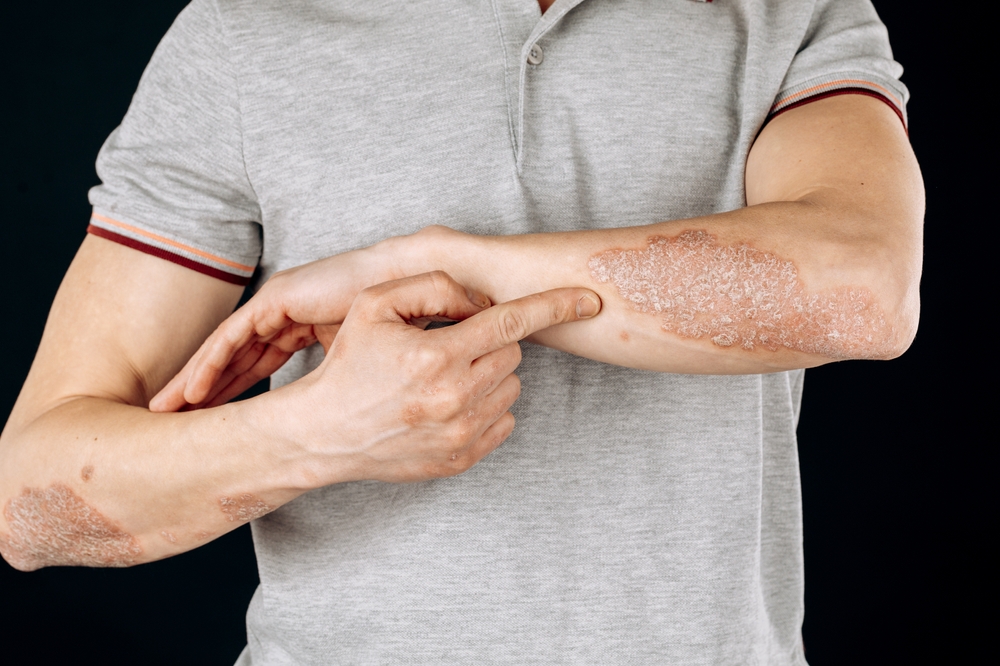Psoriasis is a skin disease with a range of variants and many known comorbidities. While the pathology of psoriasis is complex and still not fully understood, it is now accepted as a systemic immune-mediated inflammatory disease – paving the way for the development of game-changing treatments.
The burden of psoriasis
According to worldwide figures, psoriasis affects 2-3% of the population, or 125 million people worldwide, with an equal male-female ratio.
Its variants include: plaque psoriasis/ psoriasis vulgaris, affecting 85-90% of all psoriasis patients; scalp (45-56%); nail (50%); guttate (8%, mainly children); inverse (21-30%); and erythroderma (2%, a medical emergency). Some 30% of all people with psoriasis will go on to develop psoriatic arthritis (PsA).
Like many skin conditions, psoriasis is frequently overlooked by medical researchers as it is not in itself life-threatening. Yet its burden is considerable in terms of both quality of life and social integration.
According to the Resolution on Psoriasis adopted by the World Health Assembly in 2014, it is “a chronic, noncommunicable, painful, disfiguring and disabling disease for which there is no cure”.
Furthermore, “in addition to the pain, itching and bleeding caused by psoriasis, many affected individuals around the world experience social and work-related stigma and discrimination.”
Additionally, psychological discomfort, worries, poor sleep quality, concentration issues and even suicidal thoughts are noted, worsening according to the severity of the psoriasis.
The economic cost of psoriasis
Unsurprisingly, psoriasis has significant economic costs, in terms of both lost productivity and treatment.
One multinational study found that the mean percentage of total work productivity loss (WPL) for respondents with mild, moderate and severe psoriasis were respectively 10.1%, 18.9% and 29.4%.
Furthermore, an evidence review in the USA found that direct costs ranged from $51.7-63.2 billion, indirect costs from $23.9-35.4 billion, and comorbidities $36.4 billion in 2013 US dollars.
The total annual US cost of psoriasis amounted to around $112 billion in 2013, with each patient paying an average lifetime cost of $11,498 for relief of physical and emotional symptoms.
Comorbidities of psoriasis
Psoriasis is linked to several serious conditions – some of them life-limiting or life-threatening. In the WHA’s Resolution on Psoriasis, these are listed as “cardiovascular diseases, diabetes, obesity, Crohn disease, heart attack, ulcerative colitis, metabolic syndrome, stroke and liver disease”.
A systematic review and meta-analysis found that people with psoriasis are 59% more likely to get any type of diabetes, rising to 97% more likely in those with severe disease.
Severe psoriasis is linked with excess mortality, with one UK study finding that male patients died 3.5 years younger and female patients 4.4 years younger than those without the disease.
Cardiovascular disease caused the most deaths, though there was also a somewhat increased risk of dying from malignancies, chronic lower respiratory disease, diabetes, kidney disease and dementia.
Cancers linked to psoriasis include non-melanoma skin cancer, lymphoma and lung cancer.
Comorbidities are particularly common and severe among patients with psoriatic arthritis (PsA).
A metareview of 11 studies found that patients with PsA have a 43% higher risk of cardiovascular disease, with a 55% higher risk of incident cardiovascular events. Morbidity risks for myocardial infarction rose by 68%, cerebrovascular disease by 22%, and heart failure by 31%.
A separate study found that 33.1% of those with PsA developed fatty liver disease.
Immunotherapy for systemic inflammation
There is a growing consensus that innate and adaptive immune cells – especially dysfunctional helper T cells – are key to the chronic inflammatory process that underlies psoriasis.
T cells, also known as T lymphocytes, produce small signalling proteins called cytokines, causing inflammation and driving keratinocyte proliferation in psoriasis.
Therefore, the focus of medical research into psoriasis now is immunology, with therapies aiming to block cytokine production and disrupt T cell signalling pathways.
However, despite advances in immunotherapy, psoriasis is often not treated systemically until the disease worsens.
In the UK, NICE standard treatment pathways start with topical therapies such as corticosteroids, calcitriol (Vitamin D), and treatments to remove scale eg salicylic acid, emollients and oils. As the disease progresses, treatment escalates to phototherapy: narrowband ultraviolent B (UVB) or psoralen with local ultraviolet A (PUVA).
It is only in more severe cases, once other treatments have been tried, that a systemic approach targeting the immune system is taken, with conventional treatments such as methotrexate or ciclosporin, or targeted immunotherapy, such as monoclonal antibodies or deucravacitinib.
Transformative treatment for psoriasis and its comorbidities
Furthermore, existing psoriasis treatments carry risks, which may be exacerbated by factors such as obesity or diabetes. Some therapies take months to work, and patients discontinue due to loss of effectiveness and side effects, leading to biologic resistance.
Safe, cost-effective and fast-acting systemic treatments are urgently required to transform the therapeutic landscape for this debilitating disease.
Arctic Therapeutics is committed to developing novel and transformative medicines to create a better future for people in critical need of new treatment options. Find out more about our treatment for inflammatory skin diseases.

